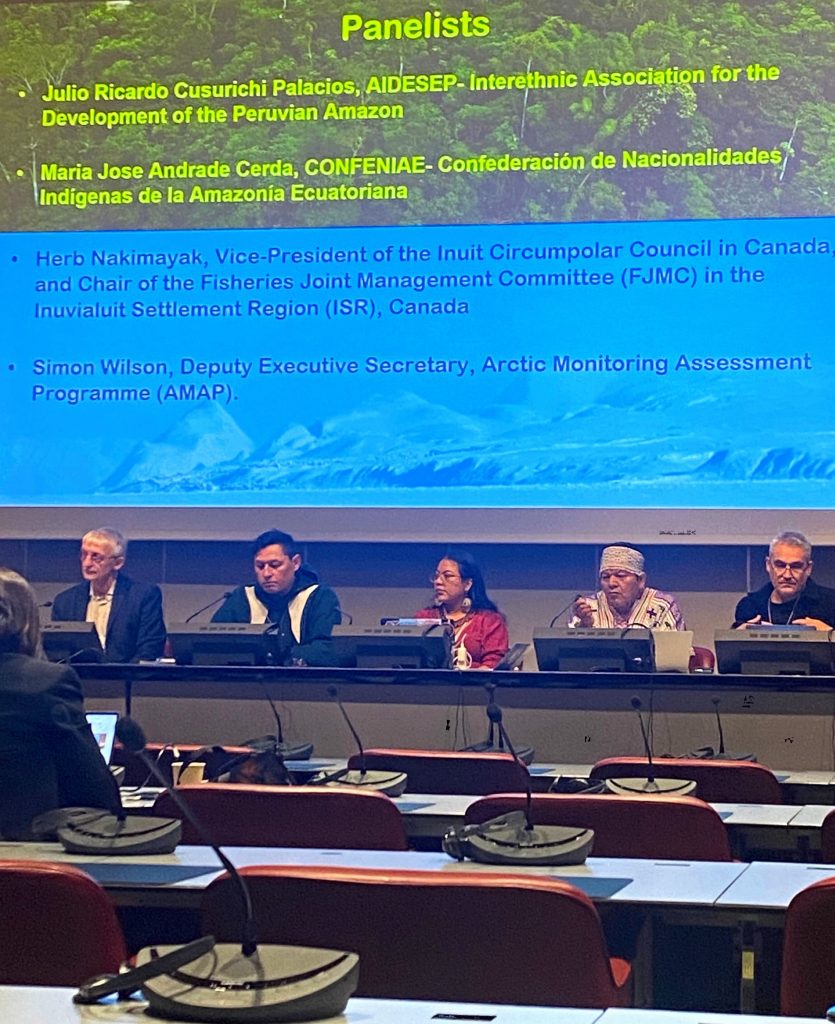By Kaura Reyes Villarán
On day 3 of the Minamata Convention, we were able to attend different contact groups. This blog is focused in the Indigenous People in the Arctic an Amazon: Monitoring Experiences and the Implementation and the Evaluation of the Minamata Convention. It was presented by the panelists: Julio Ricardo Cusurichi Palacios from the Interethnic Association for the Development of the Peruvian Amazon, María José Andrade Cerda from the Confederation of Indigenous Nations in the Ecuadorian Amazon, Herb Nakimayak which is the President of the Inuit Circumpolar Counsil in Canada and Salmon Wilson, the Deputy Executive Secretary of the Arctic Monitoring Assessment Programme (AMAP).
Indigenous peoples in the Arctic and the Amazon are amongst the highest people exposed compared to other populations. The Arctic is receiving mercury through long-range environmental transport. On another hand, the Amazon source region is due to artisanal small scale gold mining (ASGM). According to a figure presented in the panel, the percentages of Nunavik women in three different areas across the Arctic of child-bearing age with blood mercury above the Health Canada Guideline are 78%, 47%, and 43%. Artisanal and small scale mining, biomass burning, and deforestation are the main activities involving mercury in the region. There is occupational exposure to inorganic mercury via dermal contact and inhalation during the burning of the amalgam. There is also dietary exposure to methylmercury from fish growing in perturbed and degraded ecosystems.
Madre de Dios is one of the main mines in the Amazon. It is located in Peru. It is 60% protected land and home of seven indigenous people communities. There is a problem of deforestation in an area of 115,000 ha. Andrade expressed that the government is not working with the indigenous people. The state declares emergency state and then forgets about it. She emphasized that awareness and support are necessary. There is a problem with territories water and the food that they eat is contaminated. She stated that is important to work together because no one wants another Minamata.
In Ecuador, there is a special relationship with the rivers and the land. If they get contaminated with mercury, they are scared that their generations will be affected. Since the pandemic, just one region (78-80 acres) was affected by illegal mining using almost 80 tons of mercury. People in their region are tired of having researchers take their knowledge and then go away or disappear.
Indigenous people do not have the capacities nor funds to take samples and do the research. Not only at a regional level, but also by region. All the rivers are contaminated even before reaching the Amazon in Bolivia and Peru.
It was very informative and interesting to attend this panel. Since I will represent the Latin America and Caribbean group in our simulation, it was great to hear the thoughts and concerns of the people at the Minamata Convention. It seems like there is still a lot of room to improve in the situation at the Arctic and the Amazon, but is is comforting to know that they are hearing the perspective of indigenous people in important spaces like the Minamata Convention. I hope to see soon the improvement in some of the problems presented.
